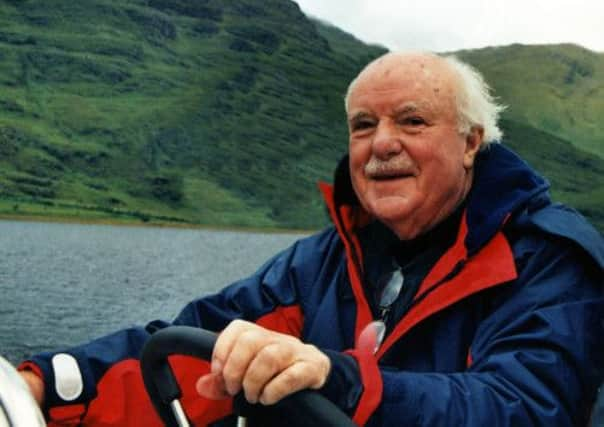Obituary: The Hon James Bruce, CBE, JP, farmer and founding chairman of Scottish Woodlands


James Bruce was an inspiring figure in land management where his commercial foresight has greatly helped to preserve the forests and woodlands in Scotland. He was passionately interested in land and its development; not only did he upgrade the land his family owned in Perthshire but he expanded their interest abroad to Saint Lucia. Bruce was a man of many interests who maintained, throughout his life, a great pride in his Scottish heritage and was much involved in many aspects of life in Perthshire.
James Michael Edward Bruce – widely known as Jamie – was the fourth child and second son of Edward Bruce, the Earl of Elgin. He attended Eton then in 1945 went to Sandhurst and later joined the Scots Guards.
Advertisement
Hide AdAdvertisement
Hide AdBruce studied agriculture at the Royal Agricultural College Cirencester, where he won the Goldstand Medal. During these years he met his first wife Margaret Coats, from Glen Tanar, Aboyne and they were married at Glen Tanar in 1950.
Bruce farmed part of the family estate around Balmanno Castle – an imposing 16th-century tower house near Bridge of Earn, Perthshire. While much of his energy and skill as a farmer was centred on the farm at Balmanno, Bruce displayed his adventurous spirit when he purchased a substantial estate in Saint Lucia.
The holding had 100 acres of alluvial soil which was ideal for banana production and 2,000 acres of coconut palms.
As the EU reduced market protection of former colonial countries the plantation had to be reassessed and other projects undertaken. Bruce expanded into developing property and hotels.
Forestry was his lifelong passion. Bruce became an authority on the commercial management of trees in Scotland and the best way to enhance wood production on private land. In 1967 he pioneered, along with several other influential landowners, Scottish Woodlands and was appointed its first – and most active – chairman. It was an innovative business that managed woodlands throughout the UK.
The company provided a comprehensive range of professional services connected to all forms of woodland management, trees and rural property.
Bruce had the foresight to establish a commercial forestry management services company and created the Scottish Woodland Owners Association (Commercial). Bruce was also chairman of the business and it too prospered, becoming one of the pre-eminent forestry businesses in the country.
The company is now a major player in the British forestry and timber industry, delivering more than 800,000 tonnes of timber per annum into UK saw mills, and planting in excess of 25 per cent of private sector new woodland expansion. The success of the company is a fitting legacy that recognises Bruce’s far-sightedness and commercial acumen.
Advertisement
Hide AdAdvertisement
Hide AdIn the company’s silver jubilee year, 1992, Bruce wrote that it was his strong desire that the equity of the company should be made available to the staff.
Through a management buy-out such a scheme was inaugurated and Scottish Woodlands is now substantially employee owned.
Bruce retired in 1992 but remained active in the business and advised on many forestry developments in Scotland. The original programme that he created for Scottish Woodlands has continued to expand and in the past two decades the company has planted more than 60,000 hectares of new woodlands. In his final year there its turnover was £15.1 million and it managed 100,000 hectares.
Bruce was active in many aspects of business life in Scotland. His most direct connection was his time on the executive committee (1971–93) of the Scottish Council for Development and Industry (SCDI). He was a made a Fellow of the SCDI in 1993.
Bruce was chairman of the Forestry Committee of Great Britain and the Game Conservancy in Scotland. He served on the Scottish Committee, the Scottish Lowland Research Committee, was a trustee of Scottish Research and an enthusiastic supporter of the annual Scone Fair. Bruce also had business interests in the Kirkforthar Brickworks and fishing trawlers.
Another passion was music and Bruce was a strong supporter of Scottish Opera (SO), serving as the company’s vice-president from 1985 to 1994. He was instrumental in many fundraising operations and much involved when SO bought the Theatre Royal in Glasgow when the demand for considerable extra income was particularly necessary.
Bruce also took a keen interest in the work of the Royal Society of the Arts, serving on its council from 1985 to 1995 and proposed a Scottish division of the RSA in Edinburgh.
Bruce, who was a keen angler and shot was also an enthusiastic gardener, was awarded a CBE in 1992.
Advertisement
Hide AdAdvertisement
Hide AdBruce’s first marriage was dissolved in 1974 and he married Morven Anne Macdonald in 1975. She died in 1994 and in 2000 he married Mary Elizabeth Hamilton. She survives him along with seven children and 14 grandchildren.